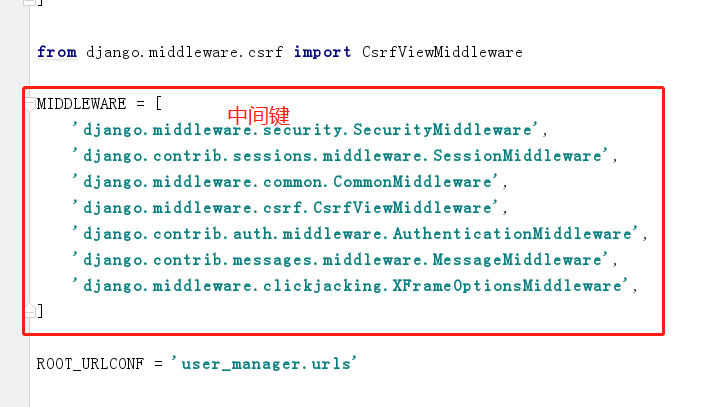
https://www.cnblogs.com/wupeiqi/articles/5237704.html
https://code.ziqiangxuetang.com/django/django-middleware.html
我们从浏览器发出一个请求 Request,得到一个响应后的内容 HttpResponse ,这个请求传递到 Django的过程如下:
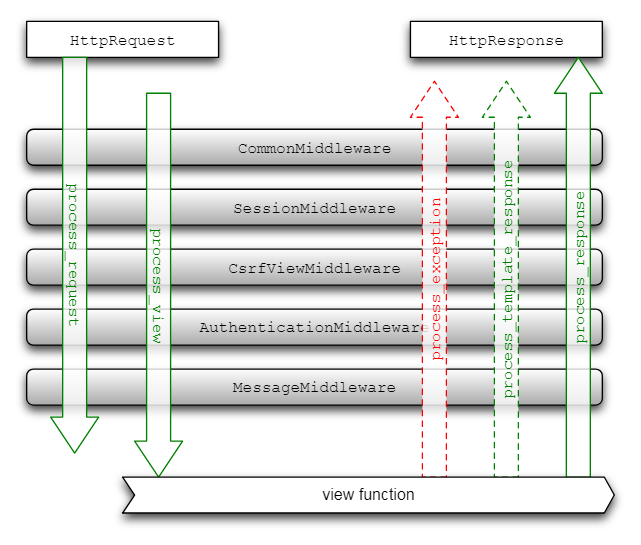
也就是说,每一个请求都是先通过中间件中的 process_request 函数,这个函数返回 None 或者 HttpResponse 对象,如果返回前者,继续处理其它中间件,如果返回一个 HttpResponse,就处理中止,返回到网页上。
中间件不用继承自任何类(可以继承 object ),下面一个中间件大概的样子:
class CommonMiddleware(object): def process_request(self, request): return None def process_response(self, request, response): return response
还有 process_view, process_exception 和 process_template_response 函数。
一,比如我们要做一个 拦截器,发现有恶意访问网站的人,就拦截他!
假如我们通过一种技术,比如统计一分钟访问页面数,太多就把他的 IP 加入到黑名单 BLOCKED_IPS(这部分没有提供代码,主要讲中间件部分)
#项目 zqxt 文件名 zqxt/middleware.py class BlockedIpMiddleware(object): def process_request(self, request): if request.META['REMOTE_ADDR'] in getattr(settings, "BLOCKED_IPS", []): return http.HttpResponseForbidden('<h1>Forbidden</h1>')
这里的代码的功能就是 获取当前访问者的 IP (request.META['REMOTE_ADDR']),如果这个 IP 在黑名单中就拦截,如果不在就返回 None (函数中没有返回值其实就是默认为 None),把这个中间件的 Python 路径写到settings.py中
1.1 Django 1.9 和以前的版本:
MIDDLEWARE_CLASSES = ( 'zqxt.middleware.BlockedIpMiddleware', ...其它的中间件 )
1.2 Django 1.10 版本 更名为 MIDDLEWARE(单复同形),写法也有变化,详见 第四部分。
如果用 Django 1.10版本开发,部署时用 Django 1.9版本或更低版本,要特别小心此处。
MIDDLEWARE = ( 'zqxt.middleware.BlockedIpMiddleware', ...其它的中间件 )
Django 会从 MIDDLEWARE_CLASSES 或 MIDDLEWARE 中按照从上到下的顺序一个个执行中间件中的 process_request 函数,而其中 process_response 函数则是最前面的最后执行。
二,再比如,我们在网站放到服务器上正式运行后,DEBUG改为了 False,这样更安全,但是有时候发生错误我们不能看到错误详情,调试不方便,有没有办法处理好这两个事情呢?
-
普通访问者看到的是友好的报错信息
-
管理员看到的是错误详情,以便于修复 BUG
当然可以有,利用中间件就可以做到!代码如下:

import sys from django.views.debug import technical_500_response from django.conf import settings class UserBasedExceptionMiddleware(object): def process_exception(self, request, exception): if request.user.is_superuser or request.META.get('REMOTE_ADDR') in settings.INTERNAL_IPS: return technical_500_response(request, *sys.exc_info())
把这个中间件像上面一样,加到你的 settings.py 中的 MIDDLEWARE_CLASSES 中,可以放到最后,这样可以看到其它中间件的 process_request的错误。
当访问者为管理员时,就给出错误详情,比如访问本站的不存在的页面:http://www.ziqiangxuetang.com/admin/
普通人看到的是普通的 404(自己点开看看),而我可以看到:
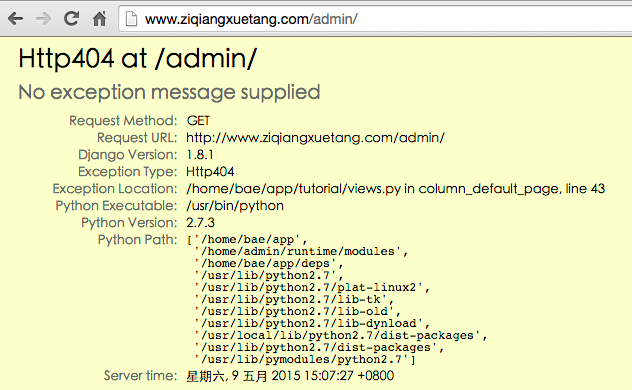
三,分享一个简单的识别手机的中间件,更详细的可以参考这个:django-mobi 或 django-mobile

MOBILE_USERAGENTS = ("2.0 MMP","240x320","400X240","AvantGo","BlackBerry", "Blazer","Cellphone","Danger","DoCoMo","Elaine/3.0","EudoraWeb", "Googlebot-Mobile","hiptop","IEMobile","KYOCERA/WX310K","LG/U990", "MIDP-2.","MMEF20","MOT-V","NetFront","Newt","Nintendo Wii","Nitro", "Nokia","Opera Mini","Palm","PlayStation Portable","portalmmm","Proxinet", "ProxiNet","SHARP-TQ-GX10","SHG-i900","Small","SonyEricsson","Symbian OS", "SymbianOS","TS21i-10","UP.Browser","UP.Link","webOS","Windows CE", "WinWAP","YahooSeeker/M1A1-R2D2","iPhone","iPod","Android", "BlackBerry9530","LG-TU915 Obigo","LGE VX","webOS","Nokia5800") class MobileTemplate(object): """ If a mobile user agent is detected, inspect the default args for the view func, and if a template name is found assume it is the template arg and attempt to load a mobile template based on the original template name. """ def process_view(self, request, view_func, view_args, view_kwargs): if any(ua for ua in MOBILE_USERAGENTS if ua in request.META["HTTP_USER_AGENT"]): template = view_kwargs.get("template") if template is None: for default in view_func.func_defaults: if str(default).endswith(".html"): template = default if template is not None: template = template.rsplit(".html", 1)[0] + ".mobile.html" try: get_template(template) except TemplateDoesNotExist: pass else: view_kwargs["template"] = template return view_func(request, *view_args, **view_kwargs) return None
参考文档:https://docs.djangoproject.com/en/1.8/topics/http/middleware/
四,补充:Django 1.10 接口发生变化,变得更加简洁
class SimpleMiddleware(object):
def __init__(self, get_response):
self.get_response = get_response
# One-time configuration and initialization.
def __call__(self, request):
# Code to be executed for each request before
# the view (and later middleware) are called.
# 调用 view 之前的代码
response = self.get_response(request)
# Code to be executed for each request/response after
# the view is called.
# 调用 view 之后的代码
return response
Django 1.10.x 也可以用函数来实现中间件,详见官方文档。
五,让 你写的中间件 兼容 Django新版本和旧版本
try:
from django.utils.deprecation import MiddlewareMixin # Django 1.10.x
except ImportError:
MiddlewareMixin = object # Django 1.4.x - Django 1.9.x
class SimpleMiddleware(MiddlewareMixin):
def process_request(self, request):
pass
def process_response(request, response):
pass
新版本中 django.utils.deprecation.MiddlewareMixin 的 源代码 如下:
class MiddlewareMixin(object):
def __init__(self, get_response=None):
self.get_response = get_response
super(MiddlewareMixin, self).__init__()
def __call__(self, request):
response = None
if hasattr(self, 'process_request'):
response = self.process_request(request)
if not response:
response = self.get_response(request)
if hasattr(self, 'process_response'):
response = self.process_response(request, response)
return response
__call__ 方法会先调用 self.process_request(request),接着执行 self.get_response(request) 然后调用 self.process_response(request, response)
旧版本(Django 1.4.x-Django 1.9.x) 的话,和原来一样。
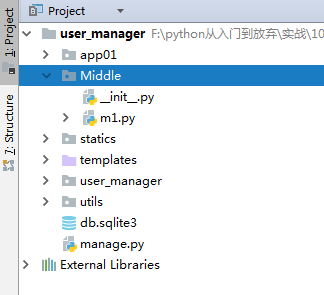
from django.utils.deprecation import MiddlewareMixin
class Row1(MiddlewareMixin):
def process_request(self,request):
print("1大王饶命")
class Row2(MiddlewareMixin):
def process_request(self,request):
print("2圣墟")
class Row3(MiddlewareMixin):
def process_request(self,request):
print("3道君")
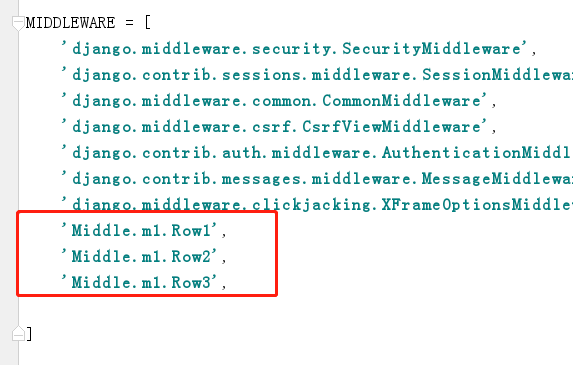
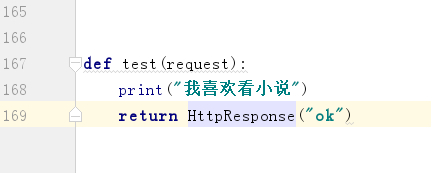
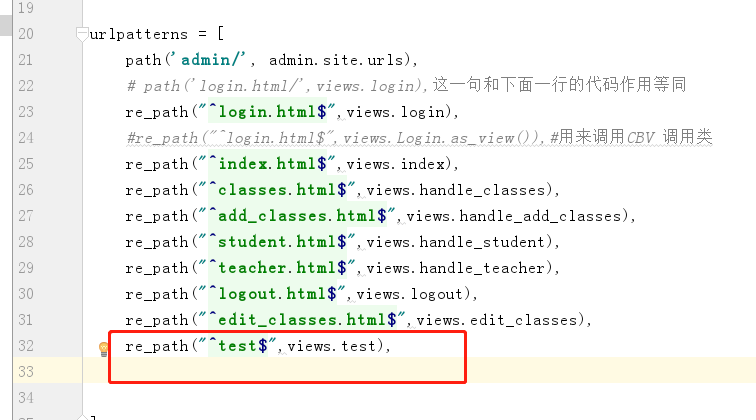
效果如下:
Not Found: / [07/Nov/2018 13:41:19] "GET / HTTP/1.1" 404 2949 1大王饶命 2圣墟 3道君 Not Found: /favicon.ico [07/Nov/2018 13:41:20] "GET /favicon.ico HTTP/1.1" 404 3000 [07/Nov/2018 13:41:28] "GET /test HTTP/1.1" 200 2 1大王饶命 2圣墟 3道君 我喜欢看小说
#!/usr/bin/env python3 #-*- coding:utf-8 -*- ''' Administrator 2018/11/7 ''' from django.utils.deprecation import MiddlewareMixin class Row1(MiddlewareMixin): def process_request(self,request): print("1大王饶命") def process_response(self, request, response): print("6 天龙八部") return response class Row2(MiddlewareMixin): def process_request(self,request): print("2圣墟") def process_response(self, request, response): print("5 汉祚高门") return response class Row3(MiddlewareMixin): def process_request(self,request): print("3道君") def process_response(self, request, response): print("4 天骄战纪") return response
结果:
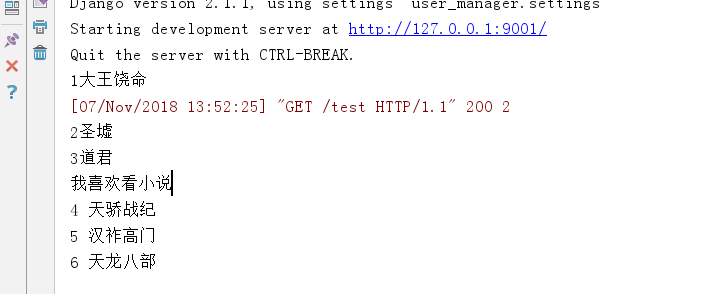
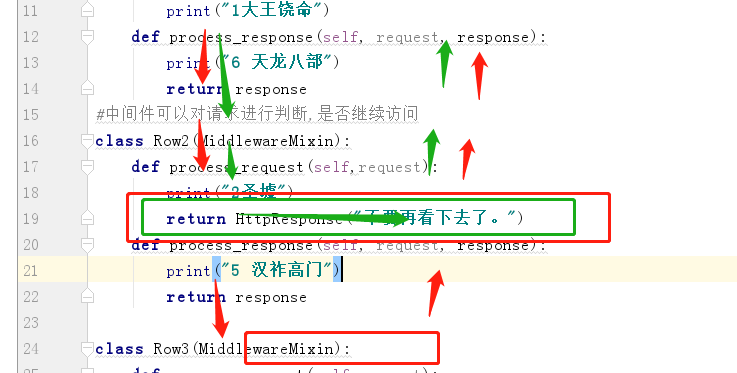
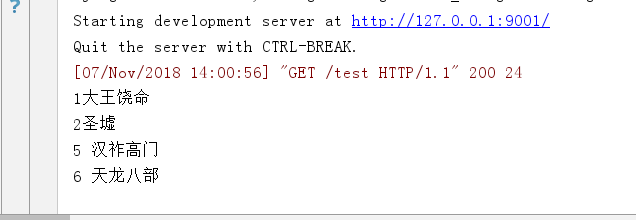
-
process_view(self, request, callback, callback_args, callback_kwargs)

#!/usr/bin/env python3 #-*- coding:utf-8 -*- ''' Administrator 2018/11/7 ''' from django.shortcuts import HttpResponse from django.utils.deprecation import MiddlewareMixin class Row1(MiddlewareMixin): def process_request(self,request): print("1大王饶命") def process_view(self, request, view_func, view_func_args, view_func_kwargs): print("1新来的。") def process_response(self, request, response): print("6 天龙八部") return response #中间件可以对请求进行判断,是否继续访问 class Row2(MiddlewareMixin): def process_request(self,request): print("2圣墟") #return HttpResponse("不要再看下去了。") def process_view(self, request, view_func, view_func_args, view_func_kwargs): print("2新来的。") def process_response(self, request, response): print("5 汉祚高门") return response class Row3(MiddlewareMixin): def process_request(self,request): print("3道君") def process_view(self, request, view_func, view_func_args, view_func_kwargs): print("3新来的。") def process_response(self, request, response): print("4 天骄战纪") return response
[07/Nov/2018 14:16:29] "GET /test HTTP/1.1" 200 2 1大王饶命 2圣墟 3道君 1新来的。 2新来的。 3新来的。 我喜欢看小说 4 天骄战纪 5 汉祚高门 6 天龙八部
def process_template_response(self,request,response): #如果视图函数返回的对象中具有render方法才能执行 print("--------------") return response
class Foo:
def render(self):
return HttpResponse("ok")
def test(request):
print("我喜欢看小说")
return Foo()
django 中的中间件(middleware),在django中,中间件其实就是一个类,在请求到来和结束后,django会根据自己的规则在合适的时机执行中间件中相应的方法。
在django项目的settings模块中,有一个 MIDDLEWARE_CLASSES 变量,其中每一个元素就是一个中间件,如下图。

与mange.py在同一目录下的文件夹 wupeiqi/middleware下的auth.py文件中的Authentication类
中间件中可以定义四个方法,分别是:
- process_request(self,request)
- process_view(self, request, callback, callback_args, callback_kwargs)
- process_template_response(self,request,response)
- process_exception(self, request, exception)
- process_response(self, request, response)
以上方法的返回值可以是None和HttpResonse对象,如果是None,则继续按照django定义的规则向下执行,如果是HttpResonse对象,则直接将该对象返回给用户。
